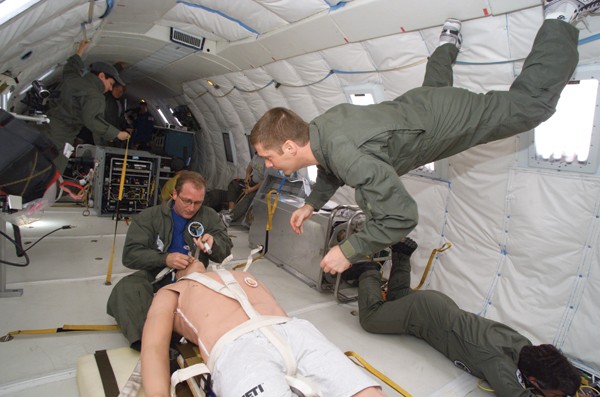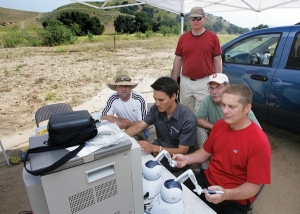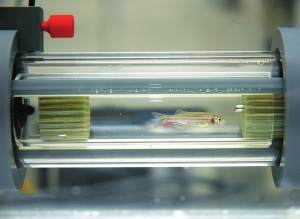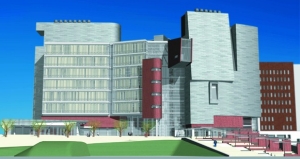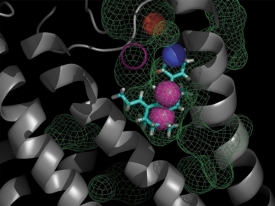What's it worth?
Everyday tens of thousands of UC faculty, staff and students wrack their brains trying to save your life … or at least make it more enjoyable. Last year, their efforts were impressive enough to attract $333.5 million from the government and corporate partners, such as Procter & Gamble, General Motors and General Electric's Aviation Division.
In short, the University of Cincinnati is becoming a research powerhouse. One-third of its budget goes toward research, and national rankings place UC in an enviable position. The National Science Foundation, for instance, ranks UC among the top 30 public research universities and 50th nationally among all universities, based on federal expenditures. Similarly, the National Institutes of Health (NIH) ranks the College of Medicine 19th among public medical schools, based upon research expenditures, placing it ahead of Ohio State University.
"We have nice numbers," says Sandra Degen, UC's vice president for research. "We don't toot our horn enough, but we win major grant competitions every year, and we're getting more industrial support all the time. It's an incredible amount of money -- a number that puts us in the big leagues."
President Nancy Zimpher agrees. "In terms of research excellence, we are one of the top research universities in the country," she says. "We're in good company at that level, and it's impressive. We should take a lot of pride in the major research enterprise that the University of Cincinnati represents."
Unfortunately, alumni and the public often overlook the university's research efforts, Degen realizes, but that is partly because much of it occurs in quiet ways. "Lots of times, what we do is really basic," she says. "It's incremental. Discoveries build on each other. "The goal is to translate our discoveries for the public good. We do that through publications, presentations, patents and licensing our intellectual property to industry." Those avenues may sound pretty dry, but it is indeed such presentations and patents that help eliminate disfiguring diseases, provide creature comforts and enlighten minds. In decades past, two UC researchers changed life as we know it -- alumnus George Rieveschl invented the first FDA-approved prescription antihistamine (Benadryl), and faculty member Albert Sabin is credited with eradicating polio in the U.S. by developing a live-polio-virus vaccine. (See related coverage on page 48.)
At the most fundamental level, "research is about knowledge creation," Degen notes. "It's about being inquisitive."
Institutions of higher education, of course, are expected to engage in research. "Most universities have three missions -- education, service and research," she says. "And universities must do research if they have graduate students."
Most recently, UC has begun to expand that student-researcher relationship to include undergraduates. A new Office of Undergraduate Research is coordinating research opportunities for pre-baccalaureate students in more than 250 programs. Last summer, nearly 150 undergraduates came to UC from across the country to work one-on-one with UC investigators.
"Our goal is to get students so excited that they'll want to go to a graduate or professional school," Degen says. "That's how I got into research. I worked in someone's lab when I was an undergraduate, and it sparked my interest."
Undergraduate opportunities are part of the reason chemistry freshman Mostafa Ibrahim of Indian Hill turned down Yale for UC, as he told Time magazine. "I think UC offers considerably more undergraduate research opportunities compared with Yale or Columbia, because it's a public school and a big research institution," he said. "I'm already finding opportunities for research."
"We're training the next generation of scientists," Degen says. "The students love it, and as faculty, we love having undergraduates in our labs because they're curious and enthusiastic. They ask questions we haven't thought about for a while."
Last fall, the College of Engineering took the blossoming undergraduate-research concept a step further in initiating a co-op research certificate program, which allows students to tailor their cooperative-education experience to match career goals in research, teaching or medicine. To accommodate the latter, it permits dual enrollment with the College of Medicine.
These students will graduate with a year and a half of research experience on their resumes, says Ed Grood, research co-op director. Some students are already conducting peer-reviewed research with internationally renowned experts at P&G. "They are actively participating and contributing to research, rather than just watching it," he says.
Another boon to UC research will be the new Center for Academic Research Excellence/Crawley Building due to open soon on the Academic Health Center campus. Attached to the existing Medical Sciences Building, the nine-floor structure will add 240,000 square feet of laboratory, education and quality-of-life space.
Although 80 percent of UC research occurs on the medical campus -- and most of that through the College of Medicine -- colleges on both campuses are working together more frequently now. "It's all about interdisciplinary research these days -- working across disciplines," Degen says. "That's where we can do cutting edge research."
Having 14 different colleges allows UC to approach research differently than many universities. Students from engineering, medicine, business and design, for example, can bring broad perspectives to collaborative projects.
"Plus, people get rejuvenated when they apply their skills to another area," Degen points out. "They get so enthusiastic. It creates a synergy that's very unique."
Because major companies also watch that synergy, UC research has a significant economic impact on the area, says Dan O'Neil, associate director of UC's Intellectual Property Office. Commercial decisions on building new facilities in Greater Cincinnati often take into consideration the high quality of UC's research and the workforce it produces, he says. Corporate VIPs sometimes come to campus and meet professors to discuss both their research and the talent of their students before final recommendations are made to the home office.
That kind of focus is a new one, O'Neil notes. "In the past, if a company were looking to locate in an area, its advance team would look at infrastructure -- roads, available building sites, power to suit their needs and adequate space. Now, the first people sent in are often the human resource people. They want to know about local talent, researchers and availability of trained people of all sorts in the area.
"What they've discovered, I believe, is it's a lot easier to build a building than it is to build a world-class research university."
Medical firsts and discoveries at UC
First live-virus polio vaccine -- In the '50s, the late pediatrics professor Albert Sabin developed the first live polio vaccine, which is credited with eradicating polio from the U.S.
First effective antihistamine -- The late professor George Rieveschl, A&S '37, MS (A&S) '39, PhD (A&S) '40, HonDoc '56, developed the first FDA-approved prescription antihistamine, Benadryl, originally marketed in '46.
First medical laser lab -- The late dermatology professor Leon Goldman, MD '29, considered the "father of laser medicine," opened the country's first medical laser laboratory at UC in 1961.
First heart-lung machine -- In 1951, cardiologist Samuel Kaplan, chemist Leland Clark and surgery professor James Helmsworth developed the world's first functional heart-lung machine, located at Cincinnati Children's Hospital Medical Center.
First YAG laser used -- In 1984, neurosurgery professor John Tew was the country's first surgeon to receive FDA approval to use the YAG laser to vaporize previously inoperable brain tumors.
First genetics center funded -- UC has the nation's first federally funded Center for Environmental Genetics (established in '82), where professor Daniel Nebert identified genes on a human chromosome that are key to lung-cancer development.
Study of birth defects pioneered -- The late pediatrics professor Josef Warkany, HonDoc '86, is regarded as the "father of teratology" (the biological study of birth defects), and his book "Congenital Malformations" ('81) is considered a medical classic, as it was the first to associate causes, not mere chance, with birth defects.
Organ transplant discovery -- In 1989, UC researchers discovered how to make a drug work more effectively to prevent rejection of a transplanted organ.
Heart-failure treatment -- Pharmacy professor Michael Bottorf helped develop national and state guidelines for the treatment of heart failure in the mid '90s.
Heart-failure gene identified -- In the early 2000s, UC researchers identified two genes that put people at 10 times greater risk for heart failure, with the gravest risk among African-Americans.
Cancer gene discovered -- In 1995, UC researchers isolated a gene that leads to an increased risk of colon cancer, which may lead to understanding how people inherit a predisposition to the disease.
Lead effects in children -- UC was the first university-based research facility to become nationally known for studying the health effects of lead in children, and the environmental-health department was one of the first to test a drug that effectively removed high lead levels from the bloodstream.
Sniffing out disease -- UC researchers Robert Frank and Robert Gesteland invented a test to measure how well a person can detect an odor, which in turn can flag brain damage early in the progression of Alzheimer's and Parkinson's diseases.
Saving preemies -- UC pediatrics professor Jeffrey Whitsett identified a protein that was both vital for lungs to operate and lacking in babies born early, which led to a routine treatment for immature lungs and respiratory distress syndrome in premature infants. The groundbreaking treatment is saving babies worldwide.
UC research, graduate programs lead rankings
Nationally, UC is ranked high in many research areas, as determined by these organizations and publications:
No. 2
Nanotechnology education -- by Small Times magazine, based upon all programs Biological sciences -- by Academic Analytics, based upon faculty scholarly productivity among more than 7.400 doctoral programs in the country
No. 3
Criminal justice -- by U.S. News & World Report, based on graduate programs Classics and classical languages -- by Academic Analytics, based upon faculty scholarly productivity among doctoral programs Industrial design -- by DesignIntelligence magazine, based on graduate programs
No. 4
Pediatrics -- by U.S. News & World Report, based on graduate programs
No. 5
Real estate -- by Journal of Real Estate Economics, based on the quality of faculty research coming out of UC's Real Estate Center
No. 6
Ecology -- by Academic Analytics, based upon faculty scholarly productivity among doctoral programs Environmental engineering-- by Academic Analytics, based upon faculty scholarly productivity among doctoral programs
No. 7
Paleontology -- by U.S. News & World Report, based on graduate programs Architecture -- by DesignIntelligence magazine, based on graduate programs Physiology -- by Academic Analytics, based upon faculty scholarly productivity among doctoral programs
No. 9
Biomedical sciences -- by Academic Analytics, based upon faculty scholarly productivity among doctoral programs
UC research statistics
Corporate research investment in UC
$8.7 million in '07 (an increase of 39.6% since '06, 66.3% since '04)
National Institutes of Health funding
College of Medicine placed 19th among public medical schools (ranked ahead of Ohio State University's medical school @ 22nd)
Largest endowments per student
UC placed 25th among public institutions w/$38,956 per student (ahead of Ohio State University @ 28th w/$34,578)
-- Chronicle of Higher Education, Aug. '07
Federal R&D expenditures for science, engineering
UC placed 45th with $202 million (ahead of Carnegie Mellon, Purdue, Rutgers, Dartmouth, Princeton)
-- Chronicle of Higher Education, Aug. '07
Endowments
UC placed 56th with $1.1 billion (ahead of Carnegie Mellon, Lehigh, Baylor, UCLA
-- Chronicle of Higher Education, Aug. '07
Expenditures at university research libraries
UC placed 50th with $22.9 million (ahead of Vanderbilt, MIT, Notre Dame)
-- Chronicle of Higher Education, Aug. '07
Inventions, patents, royalties for 2007
Invention disclosures 111
Royalty income $582,057
Patent applications 56
Patents issued 13
10 more things you may not know about UC research
1. National research leader -- The National Science Foundation ranks UC among the top 30 research institutions and 50th among all U.S. universities, based on federal expenditures, and the $333.5 million that UC and its affiliates received in total research funding last year was an all-time high.
2. Doubled in a decade -- In the last 10 years (1998-2008) UC more than doubled its research enterprise.
3. 50,500 people -- All of UC's 50,500 faculty, staff and students are needed to propel UC's research enterprise.
4. Impressive partners -- Corporate research partners include P&G, General Mills, General Motors, General Electric Aviation, Cincinnati Zoo, U.S. Steel, and Ethicon Endosurgery, among many others. Affiliates include Cincinnati Children's Hospital Medical Center, University Hospital, Shriners Hospitals for Children and the Cincinnati VA Medical Center and UC Physicians.
5. Major federal funding -- In 2007, 87 percent of UC's research support came from federal funding sources -- more than half from the National Institutes of Health.
6. Undergraduate leader -- The number of UC seniors who participate in undergraduate research with faculty exceeds UC's peer urban institutions, 21 percent at UC, compared to 14 percent elsewhere.
7. Safety conscience -- UC is fully accredited by the Association for the Accreditation of Human Research Protection Programs to assure safeguards are built into every step of research projects.
8. Drug discovery -- Procter & Gamble provides UC's Genome Research Institute with full access to its chemical compound library, containing more than 250,000 individual compounds, to enhance UC's drug discovery.
9. One of 20 in the world -- UC was one of 20 universities from around the world to compete in the Solar Decathlon competition, in which students from engineering, design, business and A&S designed and built a completely solar-powered house -- one that was innovative, workable and economically feasible.
10. $420 million gift -- In October of 2007, UC received an in-kind gift worth more than $420 million, the largest in UC history, when a consortium of international companies designated it as the state's first PACE institution (Partners for the Advancement of Collaborative Engineering Education). The gift of high-end design and engineering computer tools enable students and faculty to design hybrid vehicles, buildings, efficient factories and, eventually, innovative medical devices, then visualize their designs in 3-D and simulate bona fide tests for strength and movement.
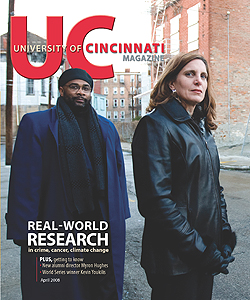
 Issue Archive
Issue Archive